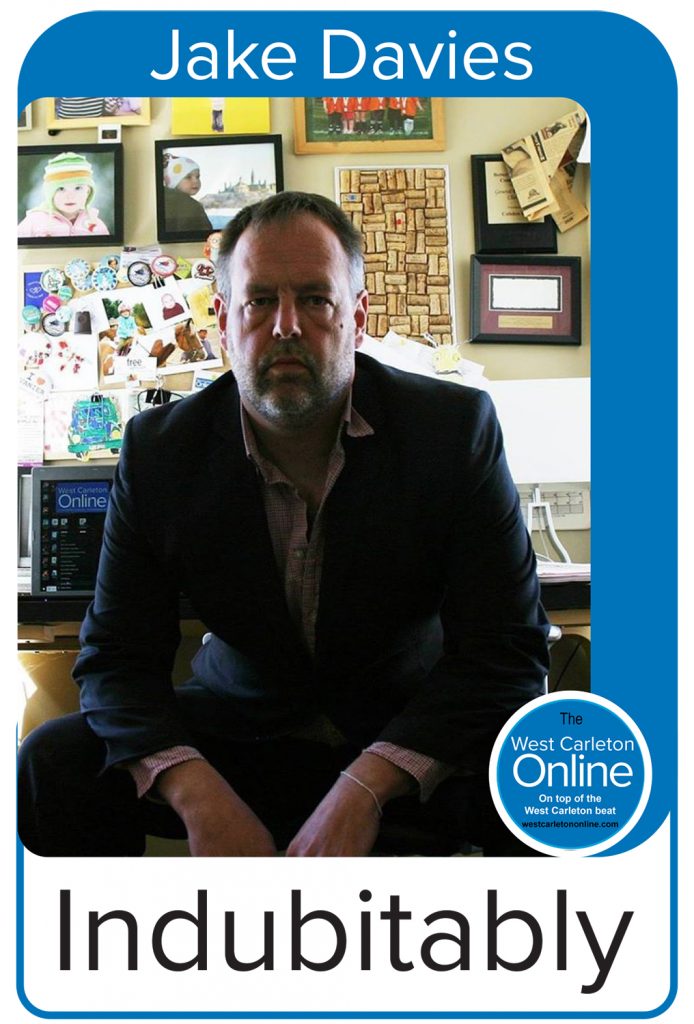Davies: Rural services budget squeeze victim
By Jake Davies - West Carleton Online
This school year started out with a whole scale life change for parents, when hundreds of West Carleton parents (maybe more, it’s hard to get a headcount) found out the day before school, their kids needed a ride to school.
While Ottawa’s public and Catholic school board trustees seemed to be more focused on social issues this summer, they forgot to make sure their students could get to school.

A service already paid for by taxpayers.
While it was billed as a new issue by the urban media, it is one West Carleton Online has been covering since at least the start of the 2020 school year.
On Sept. 11, the Ottawa Student Transportation Authority (OSTA) reported 2,360 students the organization was responsible for would be responsible for finding their own way to school “and all parents will have to get in the habit of watching for day-to-day school bus cancellations.”
In 2021 and 2023, we ran almost exact same headline 13 months apart and didn’t realize it until just now as I was “researching” this column. On, Sept. 29 we wrote ‘WC hard hit by school bus driver shortage.’ That year the OSTA reported roughly 2,000 students were without transportation.
and on Aug. 30, 2023 our headline reads ‘WC schools hit hard by bus driver shortage,’ when, at the start of this school year, more than 9,000 students needed their own ride to attend their provincially mandated school. In 2022, the issue still existed, but the headline read ‘School Bus Ontario exec expects bus shortages to continue deep in to school year.’
There is one constant in all those stories and that is bus boss OSTA general manager Vicky Kyriaco. And in every one of the stories, she says the problem is a bus driver shortage. Like there is a warehouse somewhere in the city that is usually stocked full with bus drivers, but this year, supplies have run a little low, and the OSTA is just waiting for the bus driver fairy to drop off another load of bus drivers in the warehouse, like it’s a road salt dome. In a Tweet early in August, the OSTA actually said it was not their fault.
The OSTA was created for one job. To get Ottawa students to school and back safely. Kyriaco is in charge of that job and she has failed miserably at it for the last four school years at least.
But when our Ward 5 councillor, along with some colleagues, looked for concrete solutions during a Sept. 13 OSTA meeting, after watching a video about how amazing the OSTA is, he was kicked out by Kyriaco for being “aggressive,” while looking for a solution for frustrated Ward 5 parents who have had to totally rearrange their schedule to add ‘bus driver’ to their resume.
It seems the only way to get rid of someone who is paid out of the public purse, even when they have failed at their job for four years in a row, is for that person to leave themselves.
On Oct. 2, the OSTA announced Kyriaco was taking a leave of absence. Of course, that once again just leaves parents holding the ball for a yet undetermined amount of time.
And it shines light on how the whole organization works. The OSTA says they couldn’t afford to sign a contract with a ninth bus operator this summer to ensure all public and Catholic students across the city had an equal opportunity to get to school, but it can afford to pay for a general manager’s salary who is on leave after failing to do her job, and pay for her replacement who comes in to the position with a bunch of students still looking for reliable transportation to school. I bet you those two annual salaries could hire a handful of bus operators.
That was how fall greeted West Carleton taxpayers after a winter, spring and summer of short to no notice emergency department closures across the Valley. It seemed every other weekend. This was a major issue for rural residents who watched as Carleton Place, Almonte and Arnprior hospitals seemed to rotate overnight closures of their emergency departments.
Usually, the announcement of the closure came to the media just hours before the actual closure.
Another service allegedly paid for by our taxes, the official line during these closures was, ‘don’t worry, your emergency department might not be open, but one relatively close by would be.’
Absolutely, if you are in an ambulance, it may not be a big deal to travel to the next closest emergency department (but it might be).
But for the rest of us considering a trip to the emergency department, when the injury or ailment seems like it might be serious, but not so serious you can’t take yourself to the emergency department, which I believe is the majority of emergency department visitors, you might think twice about a 45 minute to one hour round trip to the second closest emergency department as you provide your own diagnosis on your ailment.
Services we’ve already paid for are now cut, and the providers are sorry for the inconvenience. While rural emergency department closures seem to have slowed in recent weeks, I have not heard that will be the status quo moving forward.
As for busing, the OSTA has offered potential solutions, but in those listed none of them seem to include signing a contract with that ninth operator to ensure rural students have a safe and reliable way to and from school for this year and their entire school career.
These are just two recent examples of what seems to be the early signs of what may lay ahead as governments and the people who vote for them begin dealing with the financial ramification of the COVID pandemic on top of the increasing money spent on what seems to be an increasing number of environmental disasters. To deal with these ‘non-emergencies’ the executives who run these governmental organizations have decided its easier to just not offer the service than try to find the money to pay for them.
What is scary about both of these particularly rural issues is, quite quietly it seems like not providing the service is the public service’s solution to the problem. It can literally be read in the press releases issued by both the OSTA as well as as the hospitals last summer, it’s easier to ask for forgiveness than it is to ask for permission.
Top 5 Stories of August and September
West Carleton Online has its own issue these days. The Online News Act has eliminated us (and all media) from Facebook. While that hasn’t affected our paying readership, what it means for us is fewer pageviews. Fewer people find us via social media and fewer people click on our social media links (usually to find that we were serious in our post and if you weren’t a subscriber you couldn’t read the story, although we also have a history of making community emergence stories free access).
But what it means in terms of data is our Top 5 lists from the last two months are far more representative of our readers favourite, or at least most read, stories. Here are our Top 5 stories from the last two months, as always, chosen by the reader.
August
In August, we had 18,281 pageviews, which is really only about 2,000 below our monthly average. So, not that bad all things considered. And those things considered are Facebook.
- Stanley Cup coming to Carp (Published Aug. 12, 417 pageviews): Former WCMHA player Doug Davidson may not have been a superstar on the ice, but he knows a lot about teamwork, and because of that, he now has his name etched on the Stanley Cup for time immemorial.
- Constance Bay weekend beach mayhem (Published Aug. 8, 306 pageviews): A longstanding issue in Constance Bay that has no easy answers. During the summer months, especially long weekend, Constance Bay has become a tourist destination turning the small beaches there in to standing-room-only spots. While nearby residents have had their fill as narrow roads without sidewalks turn in to parking lots, businesses certainly appreciate the people coming in to the sleepy community.
- HTHS celebrates new Carp Road digs (Published Aug. 17, 176 pageviews): Carp’s keepers of history, the Huntley Township Historical Society moved in to a much-needed new space and you bet it was reason to celebrate.
- Carp’s former Karson facility eyed for development (Published Aug. 23, 174 pageviews): In a break from headline tradition, an environmental group comes out in favour of a new development.
- News-making C Bay garden in full bloom (Published Aug. 2, 158 pageviews): The Jones were ahead of the curve with their Constance Bay pollinator garden, once the centre of a media storm 14 years ago, is now the model for natural lawns across the city.
September
A more accurate look at the Online News Act’s affect as pageviews in September dropped to 15,835. Or perhaps that was just because parents didn’t have time to read the news because they were trying to find a way to get their kids to school.
- Kelly kicked of out school busing meeting (Published Sept. 15, 236 pageviews): Well, readers everywhere love controversy. And when it’s community news, and that controversy is local, all the better. Kelly said he learned a little about communications as he faced his first experience dominating the news cycle.
- Arnprior Chronicle-Guide among Metroland newspapers to close (Published June 19, 230 pageviews): West Carleton Online, of very few resources and even fewer reporters, broke this story way back in June, using a named source no less. While the official announcement came Sept. 15, our readers chose to read the breaking story published nearly three months before the official announcement.
- Bull rider seriously injured at Carp Fair Sunday (Sept. 25, 200 pageviews): There wasn’t a lot of information in this story aside from the paramedics confirming there was an injury to a competitor. But that headline was enough to make it the most clicked Carp Fair story in September.
- Carp Fair Homecoming hairy affair: (Published Sept. 22, 190 pageviews): This Carp Fair story was way more fun than the Number 3 story, plus there were beards.
- Burnt Lands tour covers all angles (Published Sept. 19, 188 pageviews): Environmental issues always do well at West Carleton Online and this story was courtesy a well-organized event to shine a light on the aggregate industry provincially and locally.












